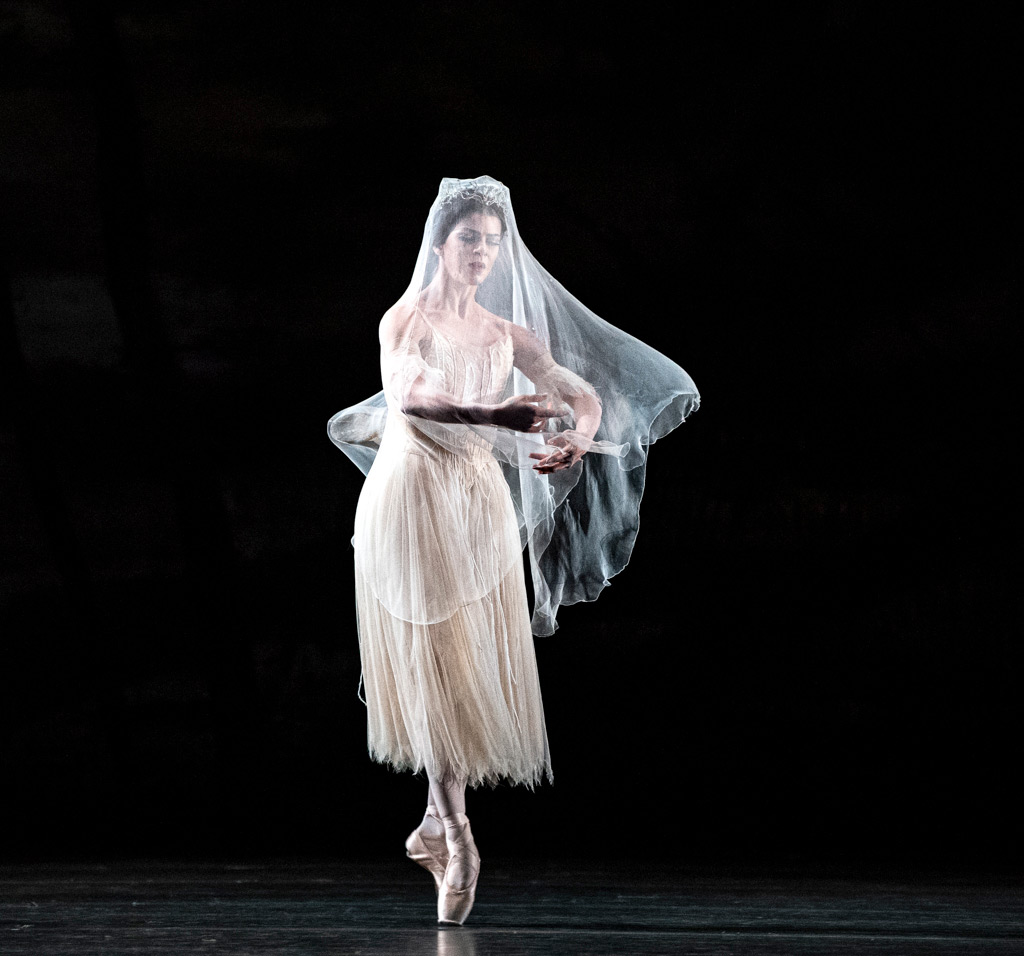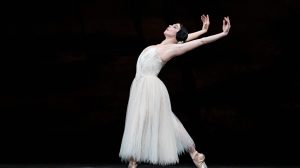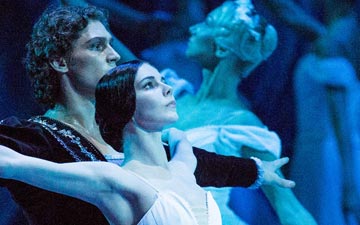
© Foteini Christofilopoulou, courtesy the Royal Opera House. (Click image for larger version)
Royal Ballet
Giselle
★★★★★
London, Royal Opera House
4 November 2021
Gallery of pictures by Foteini Christofilopoulou
www.roh.org.uk
Natalia Osipova’s Giselle is exceptional in Act II of the ballet in revealing that she is not yet in transition to becoming a Wili – a vengeful spirit who persecutes men by moonlight. Giselle certainly qualifies for the transformation; heart broken by a faithless lover, she has died before her wedding day. In the Act II initiation rite led by Myrthe, Queen of the Wilis, Giselle is summoned from her grave to be animated into supernatural life. Osipova spins as if electrified and surges across the stage, impelled by a force outside herself.
However, when she returns to comfort remorseful Albrecht (Reece Clarke), she unfolds her developpés and arabesques so slowly that she appears to be defying the spell compelling her to lure him to his death. She uses her still-human will power to save him by taking his place when Myrthe (Mayara Magri) commands him to exhaust his strength. Because Osipova doesn’t have the long line of a Romantic ballerina from the back of her neck down her shoulders and into her waist, she chooses not to droop poignantly in traditional Wili poses. Instead, she propels herself into the air, flying against gravity or lifted in great arcs by Albrecht.

© Foteini Christofilopoulou, courtesy the Royal Opera House. (Click image for larger version)
Since she is not a frail, biddable sprite, Magri’s Myrthe cannot dominate her. She tries to do so, leading her pack of Wilis with the support of her menacing lieutenants, Melissa Hamilton and Claire Calvert, but cannot prevail against Giselle’s human love for Albrecht. When dawn breaks and Myrthe and the Wilis must vanish once more, this Giselle dies a second death. Osipova becomes visibly weaker and heavier as her earthy grave claims her. Instead of drifting elusively away from Albrecht’s arms, leaving him with a flower as a memento, she’s physically dying. She’ll never rise again as a Wili.
Clarke’s Albrecht is properly distressed at losing her – as well as exhausted. He arrived to mourn by her grave looking every tall inch a danseur noble, enveloped in his sweeping cape. Although he lost his composure once he realised her presence (and mishandled a lift), his performance was admirable. A series of entrechats sixes, first introduced by Rudolf Nureyev into Act II, never lost height until spell-bound Albrecht has to fall to the forest floor. Clarke has presence as well as talent as a dancer, making an impressive debut in the role.

© Foteini Christofilopoulou, courtesy the Royal Opera House. (Click image for larger version)
In Act I, he’s an enthusiastic suitor of Giselle, entertained by her impetuosity. Her every emotion is legible from the moment she enters, anticipating his arrival at her mother’s cottage. She’s evidently besotted with him, hoping, in a secret moment of mime, to be soon engaged to marry him. She’s vulnerable as well as volatile, perturbed by the flower test that (temporarily) proves he loves her not. He does, though he is engaged to Countess Bathilde (Christina Arestis), a privileged spoilt beauty in this production by Sir Peter Wright.
Osipova’s Giselle definitely suffers from a heart condition, palpitations brought on by excitement – and dancing. She covers it up, persuading Albrecht to join her in the villagers’ celebrations of the harvest. She’s happy to dance for the visiting hunting party, seemingly improvising each section of her solo – ‘what shall I do next?’ – until she spins into a flurry of pirouettes, ending at Bathilde’s feet. Instead of a showy party piece, Osipova turns the technically tricky solo into an expression of Giselle’s impulsive temperament.

© Foteini Christofilopoulou, courtesy the Royal Opera House. (Click image for larger version)
When her trust is shattered by the revelation of Albrecht’s engagement to Bathilde, her mad scene spills out the fragments of her broken mind. She recalls tender moments that are now meaningless, remembers to curtsey to Bathilde but treats Albrecht as though he’s a stranger; she grabs his sword to hurt herself, stumbles and loses her way among the concerned group of her friends. She regains sanity just before she collapses, aware she’s about to die. Her confusion is realistically outlined, in no way overly dramatic. The villagers, stunned, leave Giselle in the arms of her mother as the curtain falls in silence. Equally stunned, the audience takes a while to applaud.
In this version of Wright’s production, Albrecht intervenes in Giselle’s distress, appalled at what he has done, rather than standing by helplessly. His treachery has been exposed by resentful Hilarion, who has to witness the consequences of his action. Lukas Bjorneboe Braendsrød’s Hilarion, tall and handsome, had rightly considered himself an accepted suitor for Giselle. His death, inflicted by the implacable Wilis, seems even more unjust than usual; like Giselle, he is a victim of Albrecht’s philandering. The corps of Wilis, back on stage en masse after their long (Covid) absence, are already well drilled, with many more performances to come to perfect their unity.

© Foteini Christofilopoulou, courtesy the Royal Opera House. (Click image for larger version)
Sir Peter, who was in the audience on Thursday’s opening night, must be very proud of his production, tweaked over the years since its staging in 1985. The Royal Ballet relishes the details of Act I: how Albrecht treats his squire, Wilfred (Thomas Mock), how the villagers react to the arrival of the aristocratic party, who serves them their drinks (is it water or wine?), just how condescending Bathilde can be. Act II, thanks to John Macfarlane’s designs, is another realm, haunted by the ghosts of dead maidens who loved to dance. Wright has included a symbolic language of flowers to assure Albrecht of Giselle’s presence – as a pure spirit, or in Osipova’s interpretation, a woman defying her transformation into a vengeful phantom. Long after its 19th century Romantic origins, Giselle survives as a ballet that offers audiences a respite from the worries of a world riven by apocalyptic fears of the future.

















You must be logged in to post a comment.